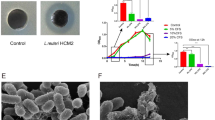Abstract
Previously, we produced two groups of gnotobiotic mice, GB-3 and GB-4, which showed different responses to Escherichia coli O157:H7 challenge. E. coli O157:H7 was eliminated from GB-3, whereas GB-4 mice became carriers. It has been reported that the lag time of E. coli O157:H7 growth in 50% GB-3 caecal suspension was extended when compared to GB-4 caecal suspension. In this study, competition for nutrients between intestinal microbiota of GB-3 and GB-4 mice and E. coli O157:H7 was examined. Amino acid concentrations in the caecal contents of GB-3 and GB-4 differed, especially the concentration of proline. The supplementation of proline into GB-3 caecal suspension decreased the lag time of E. coli O157:H7 growth in vitro. When E. coli O157:H7 was cultured with each of the strains used to produce GB-3 mice in vitro, 2 strains of E. coli (proline consumers) out of 5 enterobacteriaceae strains strongly suppressed E. coli O157:H7 growth and the suppression was attenuated by the addition of proline into the medium. These results indicate that competition for proline with indigenous E. coli affected the growth of E. coli O157:H7 in vivo and may contribute to E. coli O157:H7 elimination from the intestine.


Similar content being viewed by others
Abbreviations
- BFA:
-
Baby-flora-associated
- CFU:
-
Colony forming units
- GB:
-
Gnotobiotic
- GF:
-
Germfree
References
Benno Y, Endo K, Mizutani T, Namba Y, Komori T, Mitsuoka T (1989) Comparison of fecal microflora of elderly persons in rural and urban areas of Japan. Appl Environ Microbiol 55:1100–1105
Benno Y, Sawada K, Mitsuoka T (1984) The intestinal microflora of infants: composition of fecal flora in breast-fed and bottle-fed infants. Microbiol Immunol 28:975–986
Carman RJ, Simon MA, Fernández H, Miller MA, Bartholomew MJ (2004) Ciprofloxacin at low levels disrupts colonization resistance of human fecal microflora growing in chemostats. Reg Toxicol Pharmacol 40:319–326
Donskey CJ, Hume ME, Callaway TR, Das SM, Hoyen CK, Rice LB (2001) Inhibition of vancomycin-resistant enterococci by an in vitro continuous-flow competitive exclusion culture containing human stool flora. J Infect Dis 184:1624–1627
Freter R, Brickner H, Botney M, Cleven D, Aranki A (1983) Mechanisms that control bacterial populations in continuous-flow culture models of mouse large intestinal flora. Infect Immun 39:676–685
Gavini F, Cayuela C, Antoine JM, Lecoq C, Lefebvre B, Membre JM, Neut C (2001) Differences in the distribution of bifidobacterial and enterobacterial species in human faecal microflora of three different (children, adults, elderly) age groups. Microbial Ecol Health Dis 13:40–45
Grainger DJ, Aitken S (2004) A microtitre format assay for proline in human serum or plasma. Clin Chim Acta 343:113–118
Guiot HFL (1982) Role of competition for substrate in bacterial antagonism in the gut. Infect Immun 38:887–892
Itoh M, Wada K, Tan S, Kitano Y, Kai J, Makino I (1999) Antibacterial action of bile acids against Helicobacter pylori and changes in its ultrastructural morphology: effect of unconjugated dihydroxy bile acid. J Gastroenterol 34:571–576
Matsuki T, Watanabe K, Tanaka R, Fukuda M, Oyaizu H (1999) Distribution of bifidobacterial species in human intestinal microflora examined with 16S rRNA-gene-targeted species-specific primers. Appl Environ Microbiol 65:4506–4512
Mitsuoka T (2000) Significance of dietary modulation of intestinal flora and intestinal environment. Biosci Microflora 19:15–25
Momose Y, Hirayama K, Itoh K (2005) Antagonism of intestinal bacteria isolated from human infants against Escherichia coli O157:H7 infection in gnotobiotic mice. Microbial Ecol Health Dis 17:9–14
Momose Y, Hirayama K, Itoh K (2008) Effect of organic acids on inhibition of Escherichia coli O157:H7 colonization in gnotobiotic mice associated with infant intestinal microbiota. Antonie van Leeuwenhoek 93:141–149
Murinda SE, Roberts RF, Wilson RA (1996) Evaluation of colicins for inhibitory activity against diarrheagenic Escherichia coli strains, including serotype O157:H7. Appl Environ Microbiol 62:3196–3202
Pugsley AP, Oudega B (1987) Methods for studying colicins and their plasmids. In: Hardy KG (ed) Plasmids: a practical approach. IRL Press, Oxford, pp 105–161
Que JU, Casey SW, Hentges DJ (1986) Factors responsible for increased susceptibility of mice to intestinal colonization after treatment with streptomycin. Infect Immun 53:116–123
Reinders RD, Biesterveld S, Bijker PGH (2001) Survival of Escherichia coli O157:H7 ATCC 43895 in a model apple juice medium with different concentrations of proline and caffeic acid. Appl Environ Microbiol 67:2863–2866
Silva SH, Vieira EC, Dias RS, Nicoli JR (2001) Antagonism against Vibrio cholerae by diffusible substances produced by bacterial components of the human faecal microbiota. J Med Microbiol 50:161–164
Snoeyenbos GH (1979) Role of native intestinal microflora in protection against pathogens. Proc Annu Meet US Anim Health Assoc 83:388–393
Toshima H, Hachio M, Ikemoto Y, Ogasawara J, Hase A, Takahashi K, Masaki H, Nishikawa Y (2007) Prevalence of enteric bacteria that inhibit growth of enterohaemorrhagic Escherichia coli O157 in humans. Epidemiol Infect 135:110–117
Ushijima T, Seto A (1991) Selected faecal bacteria and nutrients essential for antagonism of Salmonella typhimurium in anaerobic continuous flow cultures. J Med Microbiol 35:111–117
Wilson KH, Perini F (1988) Role of competition for nutrients in suppression of Clostridium difficile by the colonic microflora. Infect Immun 56:2610–2614
Yamamoto-Osaki T, Kamiya S, Sawamura S, Kai M, Ozawa A (1994) Growth inhibition of Clostridium difficile by intestinal flora of infant feces in continuous flow culture. J Med Microbiol 40:179–187
Acknowledgements
We wish to thank Ms. Masako Fujiwara for technical support in studies using germfree mice. This work was supported by grants from the Yakult Bio-Science Foundation and the Morinaga Foundation for Health & Nutrition.
Author information
Authors and Affiliations
Corresponding author
Rights and permissions
About this article
Cite this article
Momose, Y., Hirayama, K. & Itoh, K. Competition for proline between indigenous Escherichia coli and E. coli O157:H7 in gnotobiotic mice associated with infant intestinal microbiota and its contribution to the colonization resistance against E. coli O157:H7. Antonie van Leeuwenhoek 94, 165–171 (2008). https://doi.org/10.1007/s10482-008-9222-6
Received:
Accepted:
Published:
Issue Date:
DOI: https://doi.org/10.1007/s10482-008-9222-6




